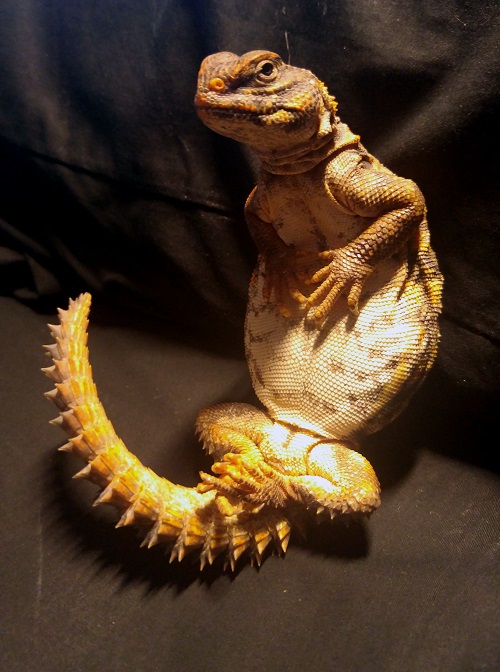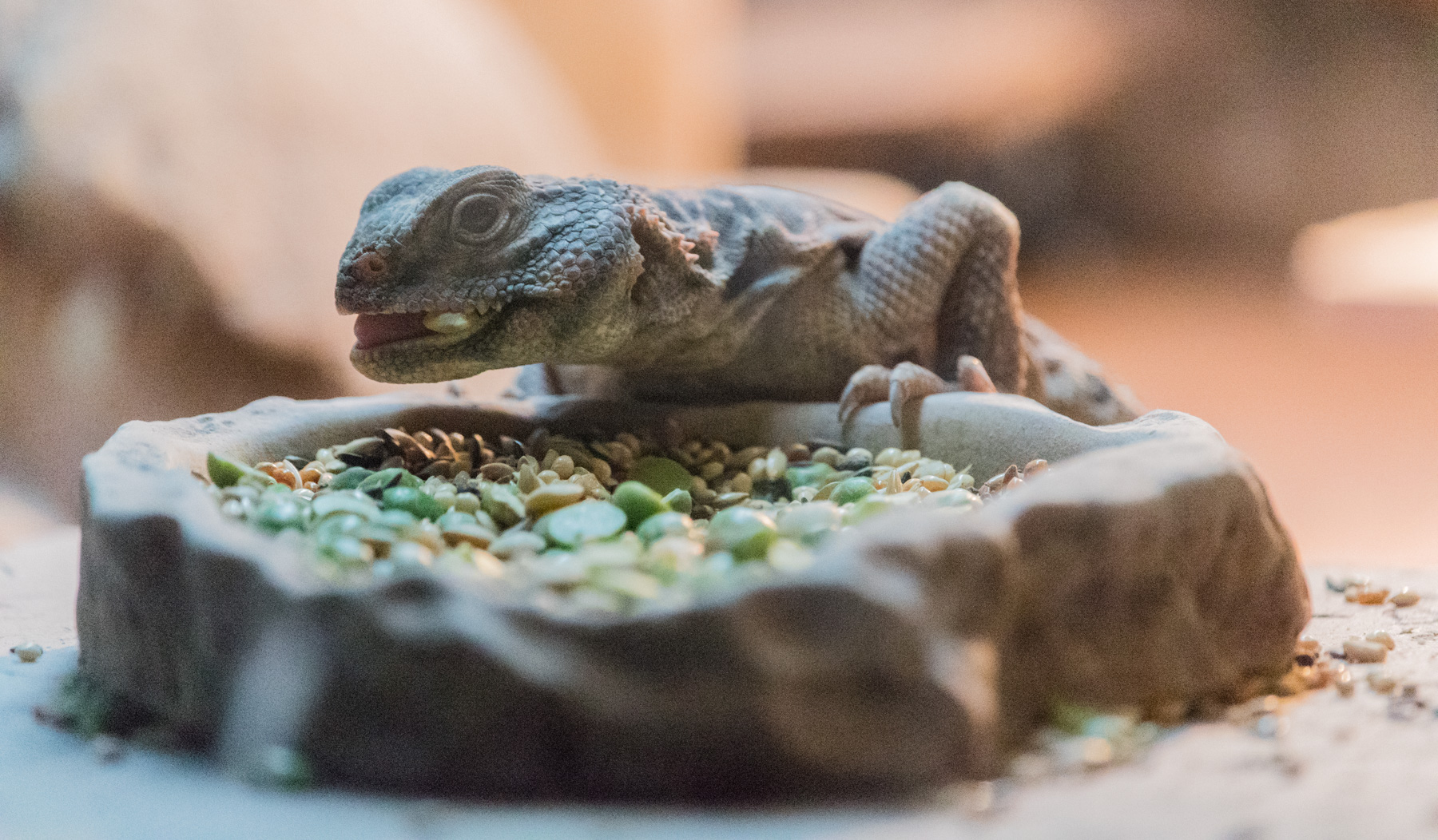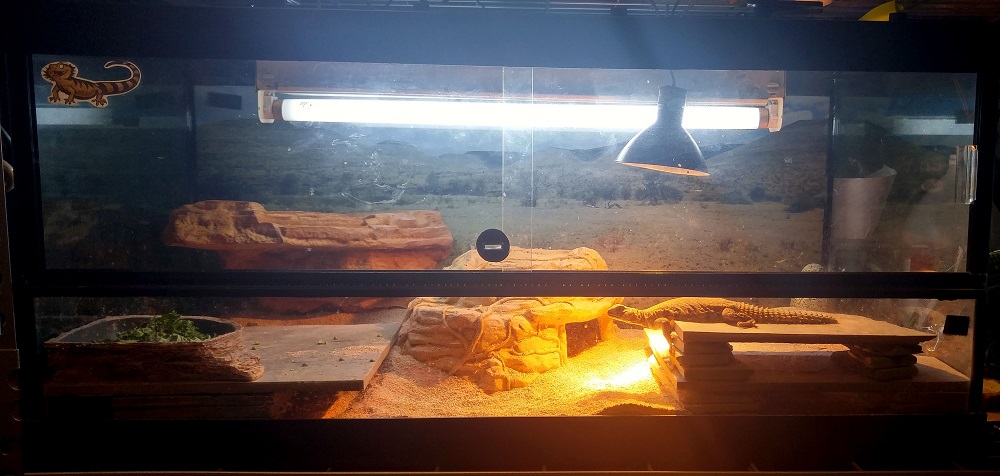Mali's Page
About Mali
 Mali is a Red Niger Uromastyx adopted on March 18th, 2017. As a female of the species, her coloration is duller than the males, but she can fire up when she's alert and awake to bring out some of the reds and oranges in her body. Her personality is more skittish than many Uromastyx, preferring to avoid human contact most of the time. However she has moments where she will come to me and spend some time cuddling. She has a burn on her side caused from an attempt to climb on her heat lamp, but it has healed very well. Measures have been taken to prevent this from happening again.
Mali is a Red Niger Uromastyx adopted on March 18th, 2017. As a female of the species, her coloration is duller than the males, but she can fire up when she's alert and awake to bring out some of the reds and oranges in her body. Her personality is more skittish than many Uromastyx, preferring to avoid human contact most of the time. However she has moments where she will come to me and spend some time cuddling. She has a burn on her side caused from an attempt to climb on her heat lamp, but it has healed very well. Measures have been taken to prevent this from happening again.
Mali's Diet
 Mali's diet is exclusively vegetarian. Her staple foods include leafy greens such as collard greens, endive, spring mix, and bok choy. In the summer, I pick dandelion greens from the yard to feed her. We use no herbicide or pesticide in our yard so after washing these are safe to eat. She also has a constant supply of a bird seed mix without sunflower seeds as well as dried lentils. She loves the lentils and her favorite veggie is iceberg lettuce. Lettuce does not have a lot of nutrition in it, so I save it as a treat. However, it does have a high water content, and as Uromastyx do not drink from standing water, iceberg lettuce can provide valuable hydration.
Mali's diet is exclusively vegetarian. Her staple foods include leafy greens such as collard greens, endive, spring mix, and bok choy. In the summer, I pick dandelion greens from the yard to feed her. We use no herbicide or pesticide in our yard so after washing these are safe to eat. She also has a constant supply of a bird seed mix without sunflower seeds as well as dried lentils. She loves the lentils and her favorite veggie is iceberg lettuce. Lettuce does not have a lot of nutrition in it, so I save it as a treat. However, it does have a high water content, and as Uromastyx do not drink from standing water, iceberg lettuce can provide valuable hydration.
Mali's Home
 Mali lives in the cage seen in this picture. It no longer has sand in it as I found that was to dusty. Instead there are a multitude of various sized hides made from slate tile for her to climb on and hide in. The surface temp of her basking spot hovers around 120 degrees Fahrenheit while the cool side of the cage has surface temps in the mid 70's. There is also a heat pad under the cage positioned under one of her hides that keeps the surface temp at around 70 all night long. This allows her to choose the sleeping area most comfortable for her.
Mali lives in the cage seen in this picture. It no longer has sand in it as I found that was to dusty. Instead there are a multitude of various sized hides made from slate tile for her to climb on and hide in. The surface temp of her basking spot hovers around 120 degrees Fahrenheit while the cool side of the cage has surface temps in the mid 70's. There is also a heat pad under the cage positioned under one of her hides that keeps the surface temp at around 70 all night long. This allows her to choose the sleeping area most comfortable for her.
Observations on Uromastyx Care
Uromastyx are generally known as a burrowing species of lizard, and sand or another substrate the lizard can dig into has generally been considered a recommendation for anybody keeping this species of lizard. However, in researching the wild behaviors of the specific species of Uromastyx I have (Uromastyx geyri), I've found that while they are found in the Saharan desert, they primarily live around rockey areas, and prefer not to burrow in sand, but instead find cracks and small holes in the rock outcroppings to use as hides. They will frequently have multiple nearby hides to retreat to in case of perceived danger, so I have adapted Mali's cage setup to reflect this. Sand has been replaced with bare tile, and hides are made of stacked (and glued) tile high enough to snugly fit Mali inside. In general, an Uromastyx will prefer a hide that allows both the top and bottom of its body to touch the surfaces, so previous store bought hides that are domed in shape were removed. After making this change, I have noticed that Mali spends more time active and observing the area around her, and has become much more adventerous.
When it comes to allowing a lizard to absorb heat, the general rule is that you do not provide underbody heat. However, an Uromastyx needs to have fairly high heat levels to stay out of brumation. At comfortable levels for most homes, the temperature can drop below this threshold at night, so I began heating the floor of Mali's tank underneath one of her hides. With the heat pad I use, as well as the layer of felt underneath the tile, the surface temperature is maintained at between 70 and 75 degrees Fahrenheit. Mali seems to prefer staying in this hide at night, and became even more active once I introduced this extra heat into the enclosure.
All content and code, unless otherwise specified, is copyright 2004 - 2018 Callen Magnuson.
mmmh... spam...